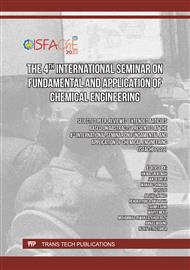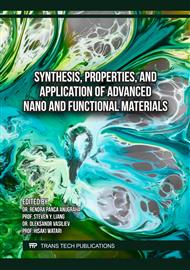[1]
Pusat Sumber Daya Mineral Batubara dan Panas Bumi, Potensi Logam Tanah Jarang Di Indonesia, 1st ed., Kementerian Energi dan Sumber Daya Mineral, Bandung, 2019.
DOI: 10.21787/mp.3.2.2019.109-118
Google Scholar
[2]
Pusat Data dan Teknologi Informasi Energi dan Sumber Daya Mineral, Kajian Potensi Mineral Ikutan Pada Pertambangan Timah, Kementerian Energi dan Sumber Daya Mineral, Jakarta, 2017.
DOI: 10.21787/mp.3.2.2019.109-118
Google Scholar
[3]
D. Yan, S. Ro, S. O, S. Kim, On the Global Rare Earth Elements Utilization and Its Supply-Demand in the Future, in: Earth Environ. Sci., IOP Publishing, 2020.
DOI: 10.1088/1755-1315/508/1/012084
Google Scholar
[4]
Q. He, Experimental study on polishing performance of CeO2 and nano-SiO2 mixed abrasive, Appl. Nanosci. 8 (2018) 163–171.
DOI: 10.1007/s13204-018-0657-4
Google Scholar
[5]
J.A. Mcneice, An Investigation Into Cerium Oxidation Under Acidic Conditions, Queen's University, 2018.
Google Scholar
[6]
C.K. Gupta, N. Krishnamurthy, Extractive Metallurgy of Rare Earths, CRC Press, New York, 2005.
Google Scholar
[7]
Y. Wu, M. Song, Q. Zhang, W. Wang, Review of rare-earths recovery from polishing powder waste, Resour. Conserv. Recycl. 171 (2021).
Google Scholar
[8]
F. Xie, T.A. Zhang, D. Dreisinger, F. Doyle, A critical review on solvent extraction of rare earths from aqueous solutions, Miner. Eng. 56 (2014) 10–28.
DOI: 10.1016/j.mineng.2013.10.021
Google Scholar
[9]
M.E. De Vasconcellos, C.A.D.S. Queiroz, A. Abrão, Sequential separation of the yttrium - Heavy rare earths by fractional hydroxide precipitation, J. Alloys Compd. 374 (2004) 405–407.
DOI: 10.1016/j.jallcom.2003.11.038
Google Scholar
[10]
M.. Purwani, K. Trinopiawan, H. Poernomo, Suyanti, N. Pusporini, R.A. Amiliana, Separation of Ce, La and Nd in rare earth hydroxide (REOH) by oxidation with potassium permanganate and precipitation, J. Phys. 1198 (2019) 32003. https://doi.org/.
DOI: 10.1088/1742-6596/1198/3/032003
Google Scholar
[11]
R.D. Abreu, C.A. Morais, Purification of rare earth elements from monazite sulphuric acid leach liquor and the production of high-purity ceric oxide, Miner. Eng. 23 (2010) 536–540.
DOI: 10.1016/j.mineng.2010.03.010
Google Scholar
[12]
T. Handini, B. Ehb, S. Sukmajaya, D. Biyantoro, Pembuatan Y Oksida Melalui Proses Pengendapan, in: Prosiding Seminar Nasional Teknologi Energi Nuklir, 2016: p.281–288.
Google Scholar
[13]
A. Novriyanisti, R. Prassanti, K.S. Widana, Pemisahan Unsur-unsur pada Monasit Bangka dengan Pengendapan Bertingkat, Eksplorium. 42 (2021) 69-76.
DOI: 10.17146/eksplorium.2021.42.1.6093
Google Scholar
[14]
I. Hastiawan, F. Firmansyah, Juliandri, D.R. Eddy, A.R. Noviyanti, Pemisahan Lanthanum Dari Limbah Hasil Pengolahan Timah Dengan Menggunakan Metode Pengendapan Bertingkat, Chim. Nat. Acta. 4 (2016) 93–96. https://doi.org/.
DOI: 10.24198/cna.v4.n2.10678
Google Scholar
[15]
A. Yulandra, I.M. Bendiyasa, H.T. Bayu, Optimasi Pembuatan Konsentrat Y(OH)3 Dan Nd(OH)3 Dari Konsentrat Tailing Zirkon Dengan Metode: "Response Surface Methodology, Universitas Gadjah Mada, 2020.
DOI: 10.32423/jmi.2020.v42.28-34
Google Scholar
[16]
S. Effendi, A. Mutalib, A. Anggraeni, H.H. Bahti, Penggunaan Desain Plackett Burman untuk Seleksi Parameter Pemisahan Logam Tanah Jarang Kelompok Sedang dari Logam Tanah Jarang Kelompok Lainnya dengan Metode Pengendapan., Al-Kimiya. 7 (2020) 1–6.
DOI: 10.15575/ak.v7i1.6486
Google Scholar
[17]
T. Moeller, H.. Kremers, The Basicity Characteristics of Scandium, Yttrium, and the Rare Earth Elements, Chem. Rev. 37 (1945) 97–159. https://doi.org/.
DOI: 10.1021/cr60116a003
Google Scholar
[18]
D. Qi, Chemical Separation Method1. Qi D. Chemical Separation Method. In: Qi DBT-H of RE, editor. Hydrometallurgy of Rare Earths [Internet]. Elsevier; 2018. p.671–741. Available from: https://linkinghub.elsevier.com/retrieve/pii/B9780128139202000076, in: D.B.T.-H. of R.E. Qi (Ed.), Hydrometall. Rare Earths, Elsevier, 2018: p.671–741.
DOI: 10.1016/B978-0-12-813920-2.00007-6
Google Scholar
[19]
N.I. Perwira, K.T. Basuki, D. Biyantoro, N. Effendy, Optimization Recovery of Yttrium Oxide in Precipitation, Extraction, and Stripping Process, in: IOP Conf. Ser. Mater. Sci. Eng., 2018.
DOI: 10.1088/1757-899X/349/1/012044
Google Scholar



